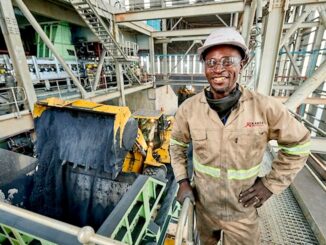
ENB Pub Note: This article is from Dan Yergin, and I had the honor of producing the podcast with him and David Blackmon that he references in the article below. Dan is spot on his assessments and we highly recommend following him on his LinkedIn here.
Forbes – July 14, 2025
In a study published in July, 2022, researchers at S&P Global projected a “looming mismatch” related to global supply and demand for copper, a critical energy metal which is integral to meeting the world’s energy needs. I wrote then that the future of copper was coming at us fast, and recent events indicate a potential crisis could well be arriving ahead of schedule.
Using Tariffs To Spur Copper Mining
As part of his administration’s efforts to incentivize major new investments in the U.S. mining sector, President Donald Trump said on July 8 that he will impose a 50% tariff on copper imports effective August 1. “I am announcing a 50% TARIFF on Copper, effective August 1, 2025, after receiving a robust NATIONAL SECURITY ASSESSMENT,” Trump wrote in a post on Truth Social. “Copper is necessary for Semiconductors, Aircraft, Ships, Ammunition, Data Centers, Lithium-ion Batteries, Radar Systems, Missile Defense Systems, and even, Hypersonic Weapons, of which we are building many. Copper is the second most used material by the Department of Defense.”
Whether the President’s strategic approach to spurring domestic investment in new mines will succeed is an open question, but his assessment of the ubiquitous presence of copper as integral to pretty much every weapons system and mode of transportation key to America’s defense is undeniable. For the Pentagon, the current situation in which the U.S. imports roughly 45% of its daily copper needs (per U.S. Commerce Department data) this represents a national security risk even though most imports originate in Chile and Canada.
But, as S&P Global’s study points out, access to adequate copper supplies is crucial to the energy sector, too, especially if the stalling energy transition is to continue in any meaningful way. Copper may well be even more crucial to meet the enormous electricity needs for AI and datacenters and the Pentagon’s rising needs due to beefed-up military spending.
Due mainly to its relative abundance and high degree of conductivity, copper has been a preferred metal in electricity applications since the days of Nikola Tesla and Thomas Edison. In its study, S&P Global describes copper as “the metal of electrification,” adding that “Unless the impending supply gap for ‘the metal of electrification’ is closed in a timely way, Net-Zero Emissions by 2050 will be short-circuited and remain out of reach.”
In a recent interview, Daniel Yergin, S&P Global Vice Chairman and author of the best-selling “The New Map: Energy, Climate, and the Clash of Nations,” told me copper is such a vital strategic resource that his company is in the process of compiling a new study to be titled “Copper in the Age of AI,” scheduled for publication in November. Yergin says his concerns about the ability of the global community to meet rapidly rising energy demands have only increased since 2022.
“I think the world is not prepared for the scale of the demand in order to meet these ambitions around AI, around defense, around energy transition, and then traditional demands,” Yergin says. “So, I think it is really critical to focus in on these minerals and what must happen to assure that you have the supply to keep your economy running.”
Timelines For Copper Mines Are A Major Roadblock
While tariffs could help jumpstart new mining projects in the U.S., Yergin warns of obstacles to increasing domestic energy security in the near term, mainly due to issues around timing. “On average around the world, it takes about 16 years from discovery of a new mine to first production. Currently in the United States, it takes 29 years,” he points out, adding, “I mean, you start and then your career is over. It’s an entire career spent on a single mine.”
We discussed the fact that, starting in the first Trump administration in 2017, repeated attempts have been mounted to streamline federal permitting processes, to little effect. Trump and his key cabinet officials – Lee Zeldin at EPA, Chris Wright at the Energy Department, and Interior Secretary Doug Burgum – have permitting reform at the top of their agenda, too. And, as Yergin points out, shrinking the timeline to first production is one of the top priorities of the new National Energy Dominance Council headed up by Burgum.
Yergin notes that there are at least two big new copper projects being developed in Arizona, but their production start dates remain years away. And, as all the administrative and congressional wheels keep spinning, there is a risk that timelines could keep extending.
“And it isn’t just permitting” that extends timelines to first production, Yergin says. “it’s the subsequent judicial review that goes on and on. There are some great proposed projects in the United States that, instead of mining ore, just end up mining legal briefs instead.”
In a detailed, comprehensive piece in Foreign Affairs published in February, Yergin, writing with Peter Orszag and Atul Arya, foresaw the looming heightened prioritization of domestic mining for copper and other critical energy minerals, predicting “a shift from ‘big oil’ to ‘big shovels.’
Such an increase would mean “more mining and processing, driven by major new investments and resulting in much-expanded industrial activity.” But, Yergin, Orszag and Arya add, “the complexities surrounding mining and critical minerals represent another major constraint on the pace of the energy transition.”
The Future For Copper And U.S. Energy Security
Unlike most other critical energy minerals, U.S. imports of copper do enjoy the current advantage of supply chains not under the dominance of China’s government. But, with the uncertain nature of Chile’s government and with China’s investments and Belt-and-Road Initiative already making significant inroads into Latin America, no one can predict how long that will remain the case. Increasing tensions between the U.S. and Canada driven by concerns over tariffs and border security issues also serve to elevate future supply concerns.
Meanwhile, America’s vibrant tech sector keeps rolling out a steady stream of new energy hungry technologies, causing overall demand to accelerate at an increasingly rapid pace. All of which means that Trump’s instinct that the U.S. should get back into the hardrock mining business in a big way is on point regardless of the way the tariff strategy plays out.
Most discussions around copper, critical energy minerals, and domestic mining over the past half-decade centered on the needs of the government-subsidized energy transition. Yergin points out that the entire energy transition project as outlined over the last several years is not happening, adding “it is a process that needs to be rethought, needs to catch up with reality.”
While that is happening, the discussion around copper and mining for it must refocus on how America will be able to keep the lights on and the electrons flowing in the coming years. It’s a complex question with no easy answers.





